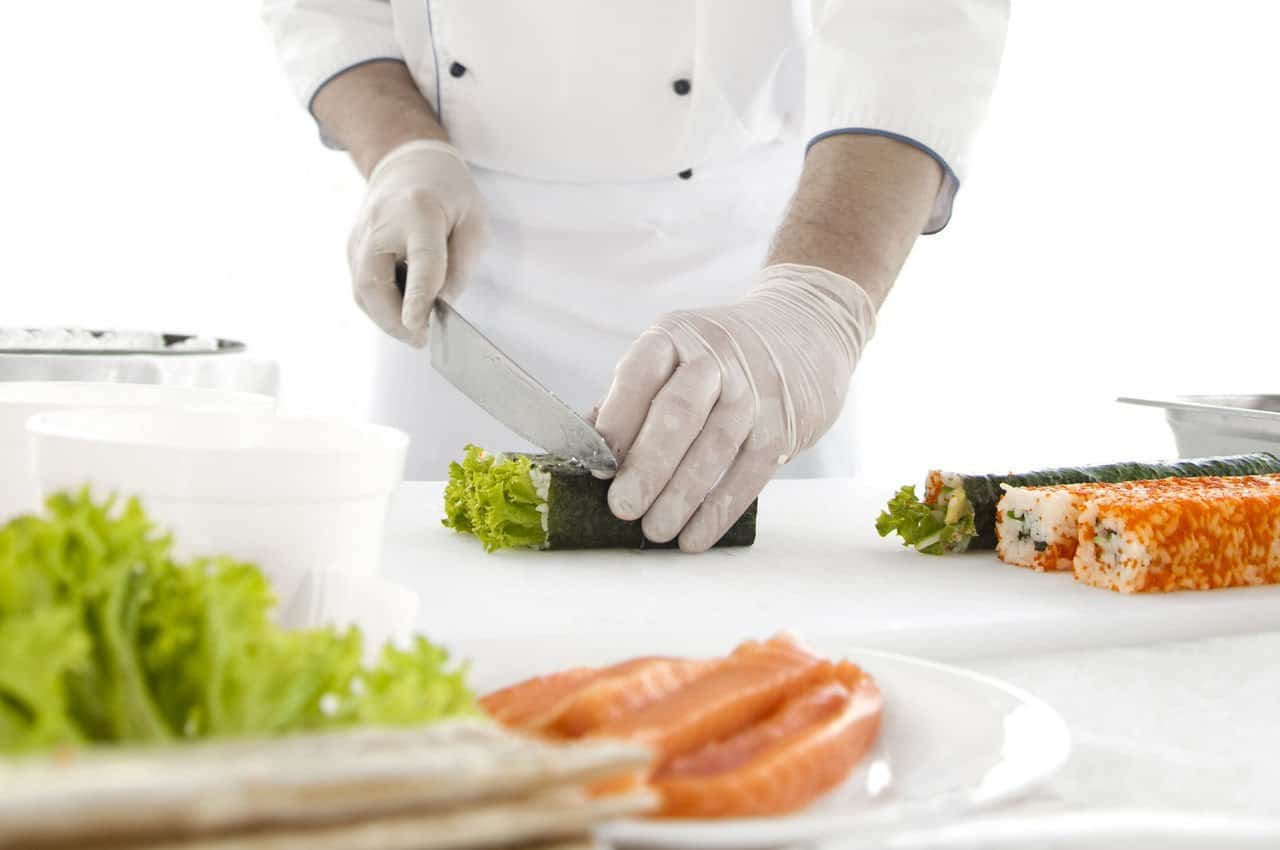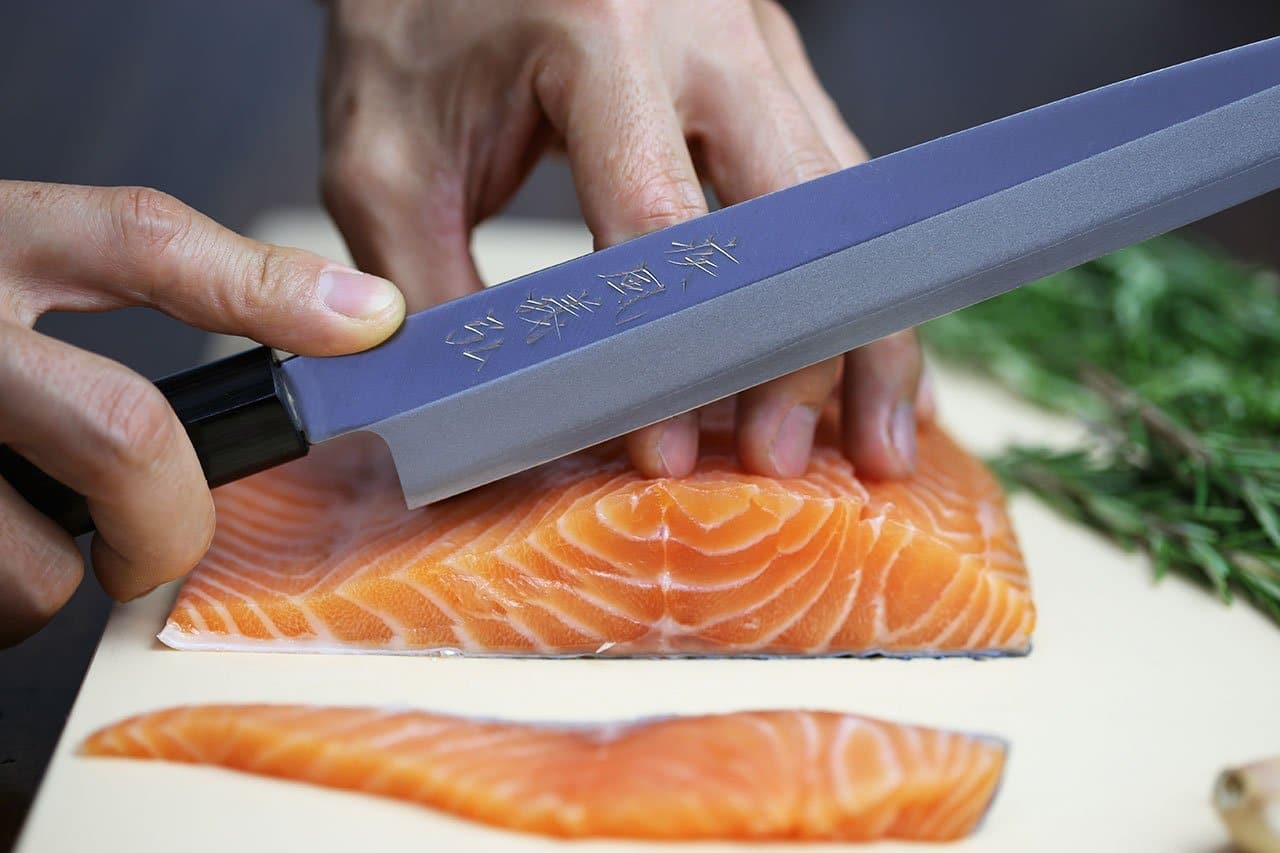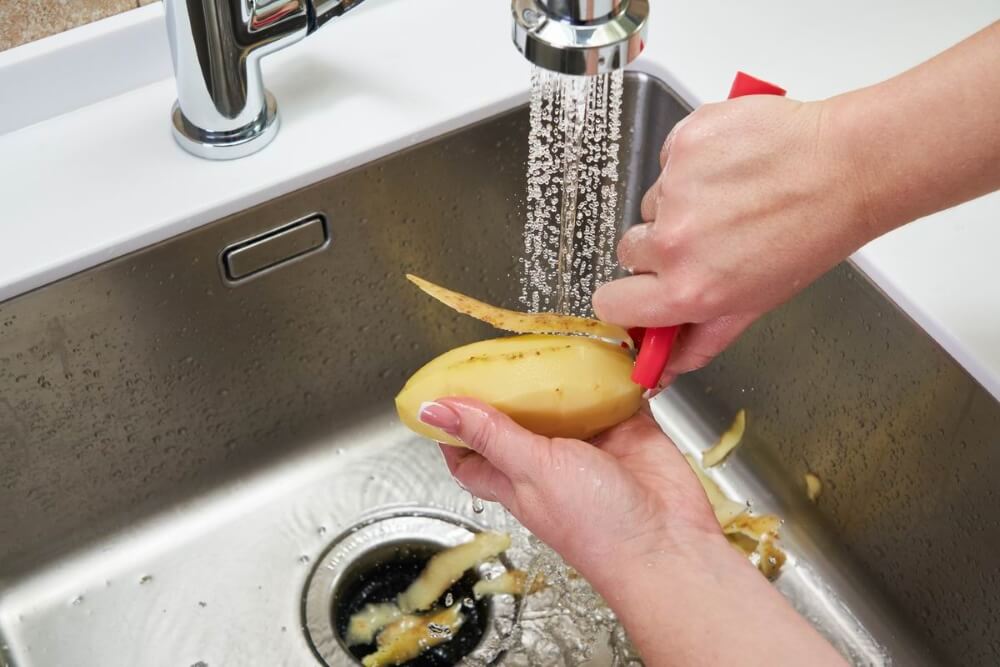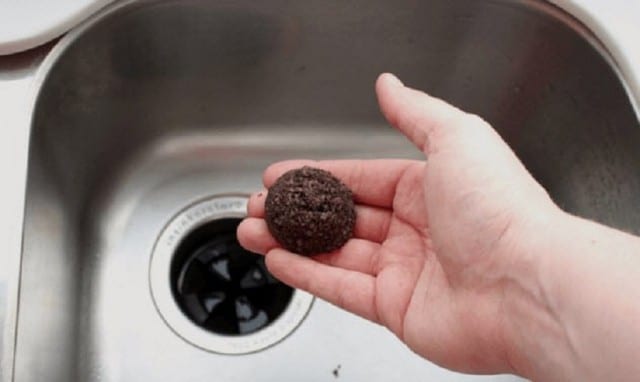Making sushi at home can be great entertainment for a weekend evening. To get a tasty result, it’s good to use a sushi knife.
We researched some of the best-selling models to choose only 6 of the best sushi knives as well as the top-rated – the Yoshihiro Japanese Sushi Chef Kasumi Knife 3p Set. When putting together our reviews, we considered several key features. The type of knife is important because each is designed for a different task. For example, some are meant to fillet, some are meant to chop vegetables. Another thing we considered is the blade material. Sharp, long-lasting blades are essential, which is why we took the Rockwell Hardness scale into account. The HRC rating tells you how hard the blade is, which determines how well the knife sharpens and how long it retains its edge. Finally, we considered handle material because a good knife handle should be lightweight, comfortable, and easy to grip.
One of the best things about the Yoshihiro Japanese Sushi Chat Kasumi Knife three-piece set is that it’s suitable for both beginners and experienced chefs. Anyone just starting out will love the versatility this set brings, and experienced chefs will really appreciate the fine craftsmanship and performance.
This set includes Yanagi, Deba, and Usuba knives. The Yanagi is an ideal sashimi knife. It’s long, narrow blade cuts thin pieces of fish and can be used to fillet other meat as well. While the Deba is also a good choice for filleting, it’s a heavier knife with a thick spine that’s perfect for butchering fish and even chicken. Finally, we have a Usuba knife meant for precisely chopping vegetables. This well-rounded set gives you the tools to do a variety of cuts.
All three of these knives feature a handle made of natural magnolia wood that is lightweight, comfortable to hold, and looks stunning against the steel blades. They also feature bolsters made of durable water buffalo horn to add strength, durability, and counter-balance for better handling.
The blades are made of Shiroko high-carbon steel with a soft iron coating. This creates a beautiful misty wave effect and the combination of these two metals makes the blade less fragile.
Each knife in this set comes with a sheath to keep the blade sharp and protected when not in use. The blades slide into the lacquered magnolia wood sheath and are held in place using a small black pin.
There are few downsides to this set. The manufacturer recommends sharpening with a whetstone, which can be an added expense if don’t already own one. Another thing is these knives are not stain resistant so they may get messy pretty quickly.
The first thing you’ll notice about the Enso Nakrir Knife is the hammered finish of the blade. It’s made of VG10 stainless steel coated in 37 layers of Damascus for a unique, handmade look. While it’s true that this style might not visually appeal to everyone, this blade has a lot more going for it than its unique finish. For one thing, it’s razor-sharp and has amazing edge retention. Plus, the double-bevel is suitable for both left and right-handed use. It comes pre-sharpened and ready to use as soon as it arrives.
This knife has a full tang which means that the end of the blade goes all the way into and through the handle instead of stopping right at the top. It’s held in place with three stainless steel rivets. Full tang knives are significantly more durable overall plus they add stability, balance, and control.
An interesting thing about this knife is that the handle is made of canvas Micarta rather than wood. Micarta is a versatile composite that’s resistant to high temperatures, resists moisture, and doesn’t get brittle or crack. In other words, its perfect for the kitchen. Micarta was truly designed to outlast anything so you don’t need to worry about this handle wearing or degrading over time. Plus, it since it was designed to look and feel like wood, this knife still has a very traditional look.
This Nakiri Knife is made in Seki City, Japan by ENSO, a company that’s been in business since 1932 and combines traditional designs and craftsmanship with modern technology. It’s of exceptional quality and is covered by a lifetime warranty. In fact, the only downside of this knife is it doesn’t come with a sheath.
Our next pick is the Kai 6715D Wasabi Black Deba Knife. The 6-inch Daido 1K6 high-carbon stainless steel blade is made for cutting paper-thin, delicate slices of fish though it can also be used to make detailed garnishes or prepare delicate herbs. It’s a little heavier than some of the other types of knives we reviewed but it’s perfect for what it was designed to do.
The blade has a beautiful brushed bead-blasted finish and a single-bevel edge for a traditional Japanese look and is stamped with the Japanese characters for “Wasabi.” It comes pre-sharpened and is ready to use right away. One downside is that the back of the knife where you rest your fingers when cutting is shaped with a bit of a harsh squared edge and can be uncomfortable when you’re using this knife for extended periods of time.
The ergonomically shaped handle is made of pakkawood, a resin-impregnated hardwood composite that has the same look and feel as natural wood but won’t crack or warp when exposed to water, heat, or other harsh elements. Plus, it has a good grip even when wet. Not surprisingly, pakkawood holds up very well in the kitchen. The black handle and shiny silver bolster against the brushed surface of the blade give this knife a distinctly modern look.
One of the few downsides to this knife is that it doesn’t come with a sheath which can make it tricky to keep the edge razor-sharp when not in use.
The Tatara Santoku Knife features a VG10 stainless steel blade with 67 Damascus layers. That means it’s not only ultra-sharp but also really durable and easy to maintain. For extra hardness and flexibility, it’s also nitrogen cooled. The result? A sharp beveled edge capable of delicate, paper-thin cuts that’s also resistant to corrosion. The full tang blade is fastened into the handle with three durable rivets for added stability plus the Granton edge keeps food from sticking for better precision.
A military grade G-10 handle maintains its grip no matter how messy or wet it gets while you’re cutting and filleting. The black handle against the dark steel of the knife gives this knife a really sleek look. It’s also ergonomically designed for comfort and has a textured surface that gives you more control over the blade while you work.
If you’re looking for a knife to give as a gift, this is a great choice. It comes in a black pinewood box lined with red velvet-like material and overall looks pretty amazing. Plus, it arrives sharp and shiny and even includes a free polishing cloth to help you keep it that way.
Although the materials and steel used to make this knife are sourced in Japan, it’s actually made in China. While they do use traditional Japanese techniques, some people might feel that this makes this knife a little less authentic. The good news is it comes with a 1-year money-back guarantee so if you decide it’s not for you, you can return it for a full refund.
If you’re looking for a great sushi knife on a budget, take a closer look at the Mercer Culinary Genesis Forged Santoku Knife. The comfortable ergonomic Santoprene handle provides a secure grip even with wet hands but still gives you easy control over the knife. Santoprene is also very resistant to extreme temperatures and substances like oil and grease so it’s right at home in the kitchen.
The blade is composed of high-carbon German cutlery steel that’s precision forged for long-lasting strength and durability. It resists rust, discoloration, corrosion, and stains, too. The rectangular shape features a Granton edge with shallow grooves to prevent food from sticking. That’s really important when you’re trying to make thin, precise cuts. These grooves fill with juices and fat while slicing through the meat so that the knife glides smoothly, quickly, and accurately.
A strong, thick bolster and full tang maintain proper balance for better control and help the blade stay stable and secure for a long time. This knife should be stored in a knife block or sheath. Unfortunately, no sheath is included.
The big downside is that this knife is that it’s lacking a bit of authenticity. It’s made in Taiwan with German components and European technology. Most of the other knives we looked at were made in Japan or at least use authentic Japanese materials. This knife does not. Does that matter? Not as far as quality. Most users have nothing bad to say about the sharpness of the blade or the performance of the handle. But if you’re looking for an authentic Japanese sushi knife, this one doesn’t really fit the bill.
Next is the Yoshihiro VGYA240SH, a Yanagi knife with a Hongasumi-grade high carbon steel blade. This steel was chosen because it maintains a sharp edge while also providing the durability and ease of care of stainless steel. It glides through fish with the application of minimal pressure to get the thin filets sushi making requires.
The single edged blade has a traditional grind that’s flat ground on the front with a concave, flat rim on the back. It comes pre-sharpened and is ready to use right out of the box. The entire blade is stain and rust resistant to make sure you get consistent results over the lifetime of the knife.
Another notable thing about this product is the gorgeous handcrafted Japanese octagonal Rosewood Shitan handle. It ergonomically designed for comfort, although it is shaped specifically for right-handed users. It also features a double ebony bolster that’s durable and lightweight and keeps the knife balanced for superior handling.
One thing about this knife that makes it really unique is that it’s 100% handcrafted in Japan by artisans who use the same kind of techniques used by Japanese swords smiths centuries ago. Nothing about this knife is mass produced which is one reason why it’s such high quality.
Also included is a beautiful magnolia wood sheath to keep the blade clean and protected when not in use. Because it’s lacquered, it won’t absorb odors or stains but still highlights the beauty of the natural wood grain.
While this knife has the potential for a razor sharp edge, it should be sharpened using a whetstone for best results.
Now that you’ve seen our reviews, let’s take a look at some of the key things to keep in mind when you’re deciding which of these knives is a good fit for you.

There are a few different features that you should consider when choosing the right sushi and sashimi knife for your kitchen. Let’s take a closer look at some of the most important ones.

A Yanagi, like the Yoshihiro VGYA240SH, has a long, thin blade that slices through sashimi in a single stroke to create a smooth, even surface that maximizes flavor. It’s single ground and has a sharper angle than is possible with a double-bevel knife. Yanagis are filleting knives and almost exclusively used with fish.
A Usuba is traditionally used for cutting vegetables. It has a flat edge with little or no curve and is tall to provide enough finger clearance for quick chopping and slicing. Plus, it’s really thin so it can make clean cuts without cracking any vegetables. Usubas are usually used by professional chefs.
A Deba is a sort of hybrid of a cleaver and a chef’s knife that’s small, curved, and have a single beveled edge for removing meat from the bone. It’s used to carve and portion whole fish but isn’t meant to cut through larger bones.
A Santoku is an all-purpose knife with a flat edge that curves down at the tip. It’s a multi-tasking tool that’s ideal for slicing, dicing, and mincing. One of the best ones we found is the Tatara Santoku knife.
Finally, a Nakiri is typically used in home kitchens and designed to cut vegetables. It has a flat profile and a square tip that make it ideal for chopping. If you want to see a great example, check out the Enso Nakiri knife.

Bevel is also something to consider when looking at blades. Most of these knives have a single bevel because you can get a much sharper angle. The thing to keep in mind is that single beveled knives are usually made for either right or left-handed use.
Another thing you’ll see in our reviews is a Granton edge. These are small indentations along the edge of the knife that are long, thin, and shallow. They come in handy when cutting anything that’s particularly wet or messy. As the knife travels through, the indentations collect the water and fat that are coming off the meat and allow the blade to move through smoothly without anything sticking. This not only makes it easier to cut, but it also makes the final product look a lot nicer and a bit more precise.
Handle material is important for a few reasons. It has to be comfortable so it’s easy to maneuver. It should also have a non-slip grip so that you maintain good control, even if your hands get messy. A lot of these handles are made out of wood but there are a lot of really great composites available, too. In some respects, composites are a little better than wood because they won’t crack or break when exposed to extreme temperatures and aren’t effected by splashes of grease or oil. The Kai 6715D knife is a great example, it’s pakkawood handle looks and feels like wood but won’t warp or crack.
The Rockwell scale tells you exactly how hard a piece of metal is. Basically, the higher the number, the harder the metal but there’s a lot more to it than that. Hard metals can hold a sharp edge better than soft metals but are more likely to crack or break. Soft metals need frequent resharpening but are a little more reliable. The trick is finding the perfect balance.
This scale specifically measures hardness, flexibility, and toughness. When these factors are balanced, you’ll have a knife that can not only take a razor-sharp edge, it will also be able to hold onto it.
For some reference, an everyday pocket knife has an HRC of about 57. High-quality steel has a hardness of 59 or higher. Our budget pick, the Mercer knife, has an HRC of 58. All the knives in the top Yoshihiro Japanese Sushi Chef set have an HRC of 63.

Santoku knives are usually about 7 inches long. Because they’re considered an all-purpose knife, they need the length to make sure they can handle as much as possible.
The other knives we looked at are about 6 to 6.5 inches long, the perfect length for cutting vegetables or butchering fish.
With rare exceptions, these knives all come with lifetime warranties. That speaks highly to their overall quality, workmanship, and materials. When you do decide which of these knives is the one for you, make sure you read the warranty carefully, just in case.
For general cooking, especially cutting raw fish and making sushi,
a set of Yanagiba and Deba (and preferably Usuba [or Nakiri] for vegetable) is recommended.
Our top pick is the Yoshihiro Japanese Sushi Chef Set, which includes Yanagi, Usuba, and Deba knives. This set gives you a lot of versatility and will get a lot of use in your kitchen, even when it’s not sushi night.
If you’re in the market for a great Yanagi knife, we recommend the Yoshihiro VGYA240SH. It has a stain and rust resistant blade and a beautiful Rosewood Shitan ergonomic handle. Best of all, it’s a really authentic sashimi knife that is handcrafted in Japan.
Finally, there’s the Enso Nakiri Knife. The hammered Damascus blade is gorgeous and maintains a razor-sharp edge and a unique double-bevel for left or right-handed use. The canvas Micarta handle will outlast just about anything but still has the look of a traditional wooden handle.





